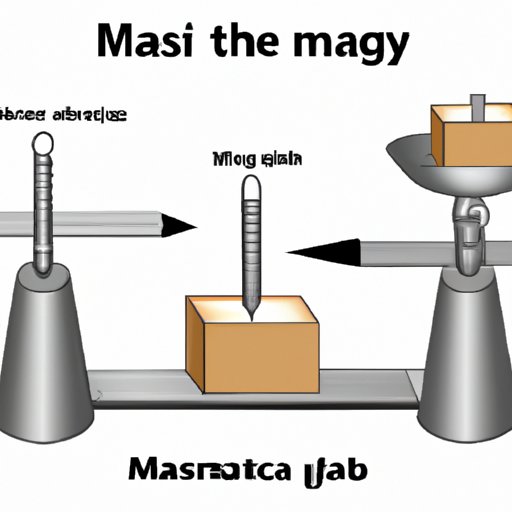
Introduction
Have you ever wondered why astronauts appear to float in space or how skyscrapers are built to withstand the weight of their own materials? Understanding the difference between mass and weight is an essential concept in physics with real-world applications that affect our daily lives. In this article, we will explore the differences between mass and weight, their respective units of measurement, and how they are calculated. We will also debunk common misconceptions about mass and weight, trace their history, and highlight the importance of accurate measurement.
Defining the Concepts
Mass is the amount of matter in an object. It is a scalar quantity, which means it has no direction and is independent of the object’s location. The units of measurement for mass include grams (g) and kilograms (kg). Weight, on the other hand, refers to the force of gravity acting on an object and is dependent on the object’s mass. Weight is measured in newtons (N) or pounds (lbs).
To calculate an object’s mass, we can use a balance or scale. Weight, on the other hand, is calculated by multiplying an object’s mass by the acceleration due to gravity (9.81 m/s² on Earth). This calculation is expressed as:
Weight = Mass x Acceleration due to Gravity
Understanding the Physics
Gravity plays a significant role in determining an object’s weight. Gravity is the force with which two objects with mass are attracted to each other. On Earth, the mass of the planet creates a gravitational force that pulls objects towards the center of the Earth. The farther away an object is from the Earth’s center of gravity, the weaker the gravitational force acting on it.
The amount of gravity also varies on different planets or in space, affecting an object’s weight. For example, a person weighing 68 kg on Earth would weigh only 25.7 kg on Mars, where the force of gravity is about 38% of that on Earth. In contrast, a person weighing 68 kg on the Earth would weigh 618.6 kg on Jupiter, where gravity is much stronger.
Objects of different masses and weights are affected differently by gravity. A heavier object will experience a greater gravitational force than a lighter object. For example, a bowling ball and a golf ball dropped from the same height will hit the ground with different speeds because of their different masses and weights.
Real-World Applications
The concept of mass and weight plays an important role in designing and building structures like skyscrapers and bridges. Engineers need to understand how much stress various materials can withstand under the force of gravity to ensure these structures remain safe and stable.
The relevance of mass and weight can also be seen in transportation and engineering. Car manufacturers must calculate how much weight a car can safely carry and distribute it evenly across the vehicle’s frame. The weight of cargo also needs to be carefully considered when designing airplanes and boats to ensure they can handle the payload and remain stable in flight or on the water.
Understanding mass and weight can also prevent accidents and improve safety in everyday life. For example, incorrect weight measurements on a construction site could lead to the collapse of a building or bridge.
Debunking Common Misconceptions
A common misconception is that mass and weight are interchangeable terms. However, this is incorrect. Mass refers to the amount of matter in an object, while weight refers to the force of gravity acting on an object’s mass.
Another common misconception is that an object’s physical size determines its weight. However, the size of an object is not directly related to its weight. For example, a small but heavy lead weight weighs more than a larger but lighter balloon.
The History of Mass and Weight
The concept of mass and weight has evolved throughout history. The ancient Greeks believed that objects fell at different speeds based on their weight. In the 17th century, Isaac Newton developed the concept of mass and gravity, which led to the creation of a system of units for mass and weight.
In ancient times, people used a variety of methods to measure mass and weight, including using balance scales and comparing the object in question to a standard weight or volume. In the 20th century, electronic scales and other advanced technologies were developed to accurately measure mass and weight.
The Importance of Accurate Measurement
Accurate measurement of mass and weight is vital in scientific research and industrial settings. Inaccurate measurements can lead to errors that compromise the quality of data or products and can even pose safety risks.
For example, in the pharmaceutical industry, precise measurement of drug ingredients is crucial to ensure they are safe and effective. In manufacturing, incorrect weight measurements of raw materials can lead to substandard products.
Conclusion
Understanding the difference between mass and weight and their respective units of measurement is essential for anyone interested in science or technology. Appreciating the impact of gravity on objects of different masses and weights is also critical for solving everyday problems and maintaining safety and stability in the built environment. We hope that this article has provided you with the information you need to understand mass and weight, and highlighted the importance of accurate measurement in various fields.
For further reading, check out books and online resources on physics or engineering. You may also want to explore scientific instruments used for measuring mass and weight, such as balances, scales, and force gauges.





